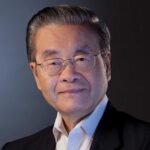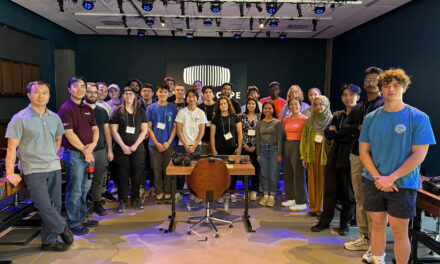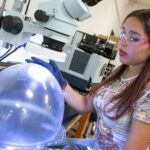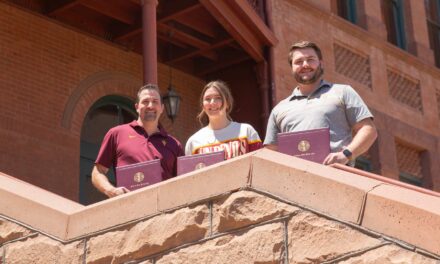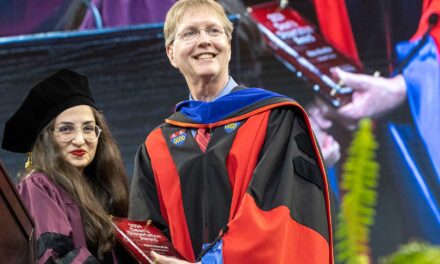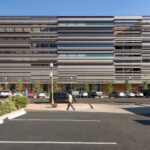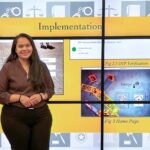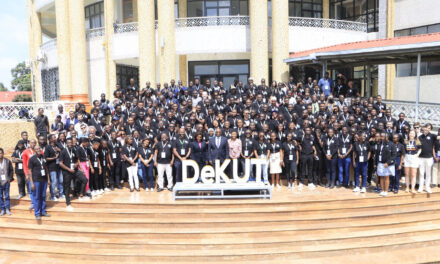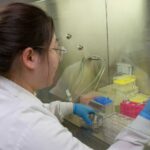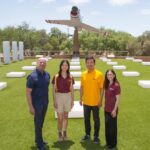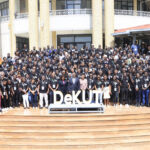
SenSIP striving to make solar energy systems more sustainable

Above: An array of photovoltaic modules built recently at the Macro Technology Works facility at the Arizona State University Research Park will be used to develop systems designed to boost the productivity and reliability of solar power generating stations. Pictured at the site are leading members of the project team. From left to right: Devarajan Srinivasan, Jeffery Frye, Andreas Spanias, and Cihan Tepedelenlioglu. Photographer: Nicholas Narducci/ASU
Making photovoltaic cells more effective is critical to unleashing the potential of solar energy to become a major source of clean renewable power.
The goal is to produce cells capable of converting more captured sunlight into electricity. But even with recent advances in conversion efficiency, another challenge remains: developing complementary technologies for solar energy generating systems that will help enable photovoltaic cells to perform at their peak.
To maximize energy generation, arrays of photovoltaic modules must be equipped to react to situations that threaten to hinder their productivity.
That’s where sensor and signal information processing technologies promise to play a big role.
Arizona State University engineers Andreas Spanias and Cihan Tepedelenlioglu are working to automate monitoring and operation of solar energy facilities in ways that provide optimal efficiency.
Self-diagnosis and predesigned remedies
Spanias, a professor of electrical engineering in ASU’s Ira A. Fulton School of Engineering, is the founding director of the Sensor, Signal and Information Processing (SenSIP) research center. Tepedelenlioglu is an associate professor of electrical engineering in the Fulton Schools of Engineering.
They are devising a system that can act on its own to change the configurations of electrical connections within networks of photovoltaic modules. That ability will make generating facilities capable of quickly overcoming technical difficulties and maintaining operations with little loss of solar power conversion activity.
More than that, they want to integrate technologies into the system that will detect, diagnose and remedy electrical and mechanical glitches that would hamper a power station’s output.
“The idea is to come up with the theoretical foundations for producing algorithms for fault detection and repair, for realigning connections among arrays of solar panels,” Spanias explains,” and to then embed these algorithms into operating systems so that they are ready to respond to problems with predesigned solutions.
“We think we can show that this will increase power output by as much as five percent, which is a lot of power when you scale things up to the size of typical utility company operations,” he says.
A system of embedded autonomous controls
With $700,000 from two National Science Foundation grants — along with support from some of SenSIP’s key industry partners — the center is completing construction at the ASU Research Park in Tempe of an experimental facility with 104 photovoltaic modules equipped with prototype “smart” monitoring devices.
At the park’s Macro Technology Works, ASU researchers will test technologies and designs for a system they hope will make solar energy generating stations significantly more robust and sustainable.
Tepedelenlioglu is concentrating on enabling the system to be monitored and controlled remotely from just about anywhere.
“Maintaining solar panel arrays in isolated locations has traditionally been a limitation of solar energy facilities,” Tepedelenlioglu says. “This system would allow utility companies to monitor each individual module and to respond to problems from far away, eliminating the need for manual repairs with people on site.”
Accomplishing that will entail combining and integrating the capabilities of sensors, signal information processors and computer programming to embed an extensive communications network into the system.
Communications network for remote monitoring
Two SenSIP industry partners, Japan-based Energy Wireless and Tempe-based Poundra, are providing photovoltaic modules, along with sensor, transmitter, transceiver and signal devices for the experimental facility.
Sprint Communications installed a dedicated LTE system in SenSIP’s lab. This networking technology for wireless communication of high-speed data for mobile phones and data terminals will be used to provide additional mobile data links as the solar energy system monitoring project progresses.
The network will need to link internal communications between the devices that monitor, control and provide data on the facility’s electrical and mechanical components with the technologies that enable offsite supervision and transmit external communications and controls back to the system.
“Sensors on each and every solar panel will communicate to a central monitoring station to report what each panel is producing, and reveal if there is something keeping the facility from functioning at its full capacity,” Tepedelenlioglu says.
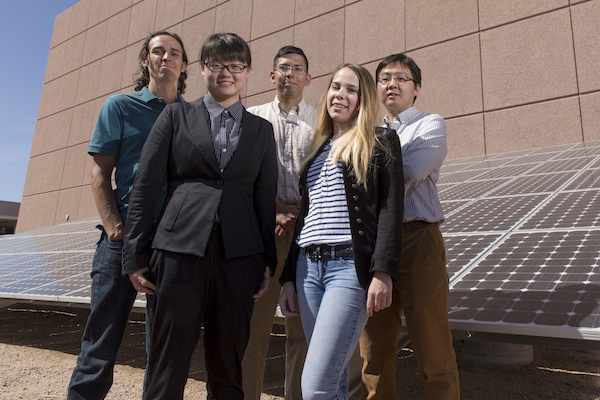
Students who are on the research team for the ASU Sensor, Signal and Information Processing research center project include (from left to right) electrical engineering doctoral students Henry Braun and Xue “Sophia” Zhang, electrical engineering undergraduate David Ramirez, biomedical science and genetics undergraduate Stefani Gjorcheska and electrical engineering doctoral student Jongmin Lee. Photographer: Nicholas Narducci/ASU
Overcoming technological hurdles
Through the communications matrix Tepedelenlioglu plans to develop, the monitoring data can be accessed wirelessly through a mobile phone or an Internet connection.
Designing and operating such a network can achieve technological progress that would also improve monitoring of other alternative energy facilities, as well as monitoring of infrastructure systems and environmental conditions.
“We want to demonstrate that sensor and signal processing has a major role to play in making solar energy advances, and that it can be adapted to help optimize the performance of many other types of similar facilities,” he says.
The project potentially offers much more than enhanced technical efficiency, Spanias says.
“With an advanced automated system that enables remote communications about the status of every facet of such a facility, and that detects, analyzes and fixes problems to maintain full production, you are going to be able to operate more economically,” Spanias says. “That helps overcome a big hurdle for solar energy.”
Boosting viability of solar energy systems
Raja Ayyanar, an ASU associate professor of electrical engineering, will aid the cause by helping to design and engineer inverter operation strategies to limit changes in power output due to system faults and periods when the photovoltaic array is shaded from sunlight, and to enable the facility to generate power in a form that is usable by the electrical grid.
Devarajan Srinivasan, an ASU alumnus, a faculty associate in the Fulton Schools of Engineering and one of the owners of Poundra, has been a key collaborator on the project since its beginning. He helped to design the experimental facility at the ASU Research Park.
Poundra works with energy industry clients to help them adapt new technologies and systems to improve the performance of their solar power generation facilities.
The company is hopeful the SenSIP project will produce technological advances “that improve not only the ability to monitor the overall health of the system in real time, but also to pinpoint where problems are arising and to predict its long-term performance over five to 10 years,” says Srinivasan, who earned master’s and doctoral degrees in electrical engineering at ASU.
That achievement would be a major boost to the viability of the solar power industry throughout the world, he says.
Contributions from industry collaborators
The facility’s “smart” monitoring electronics — including sensors, relays and communications modules —were designed by SenSIP collaborators Shinji Koizumi, Shin Takada and Yoshitaka Morimoto, who are with the Japanese companies Energy Wireless and Applied Core Technologies, which have been involved with the project since 2012.
Morimoto says the concept for remote module-based monitoring was developed in response to the extensive damage done to nuclear power facilities when a massive tsunami hit Japan in 2011. In the aftermath, the Japanese government made plans to develop remotely monitored and controlled solar energy farms to provide an alternative to nuclear power for the areas hit by the tsunami. The government gave Energy Wireless support to develop the sensor and electronics for the “smart” monitoring devices.
Macro Technology Works facilities director Jeffery Frye has been instrumental in paving the way for the building and implementation of the photovoltaic array. He was in charge of site logistics and construction coordination, as well as securing the necessary licensing and permits to operate the facility.
Frye expects to reap results from the system that could aid ASU in its quest to use solar energy to provide a greater percentage of the power needed for the university’s campuses.

The experimental facility’s array of more than 100 photovoltaic modules will be equipped with advanced “smart” monitoring devices and other technologies to enable the system to detect, diagnose and remedy electrical and mechanical glitches that would hamper a solar power station’s output. Photographer: Nicholas Narducci/ASU
Potential breakthroughs attract interest
Spanias and Tepedelenlioglu are co-authors of a paper soon to be published in the research journal Sustainable Energy, Grids and Networks. Their article reports on procedures they have devised for optimizing the electrical configurations of photovoltaic arrays under a variety of operating conditions.
The paper will provide details on an array reconfiguration algorithm they say would enable a generating facility to reliably produce more power than facilities operating without their system for realigning electrical connections among photovoltaic modules.
SenSIP’s efforts have demonstrated sufficient promise to capture the interest of Sethuraman Panchanathan, ASU’s Chief Research and Innovation Officer and Executive Vice President of Knowledge Enterprise Development (KED), as well as William Petusky, the Associate Vice President of Science, Technology and Engineering at KED, and Yong-Hang Zhang, the Associate Dean of Research in the Fulton Schools of Engineering. They, along with Stephen Phillips, director of the School of Electrical, Computing and Energy Engineering, have provided logistical and financial support for the 18-kilowatt solar energy monitoring facility.
Students benefiting from the project
ASU students are also benefiting from the project. Several engineering graduate students have roles as research assistants, and educational computer software will be developed for use in teaching undergraduates the basics of the science and engineering concepts involved in the project.
In addition to the two National Science Foundation (NSF) research grants, the NSF awarded SenSIP a Research Experience for Veterans supplement that has supported ASU undergraduate student and military veteran David Ramirez, who has already co-authored research paper and reports on solar monitoring project.
Outlook for broadening scope of efforts
Spanias and Tepedelenlioglu foresee possibilities of expanding their research endeavors in the area of green energy development, aided by SenSIP’s standing as a National Science Foundation Industry/University Collaborative Research Center that is making notable strides in its research mission.
Along with the companies contributing to the solar project, the center now counts among its primary industry partners NXP (formerly Freescale), Intel, Raytheon Missile Systems and Interactive Flow Studies, as well as associate members-at-large that include LG Electronics, Lockheed Martin, National Instruments, Qualcomm, General Dynamics, Paceco and Mitsui.
Those companies’ varied interests may lead to further support for SenSIP’s efforts to apply its sensor and signal information processing expertise to pursuing improvements in energy technologies and systems used in diverse industrial and commercial enterprises.





